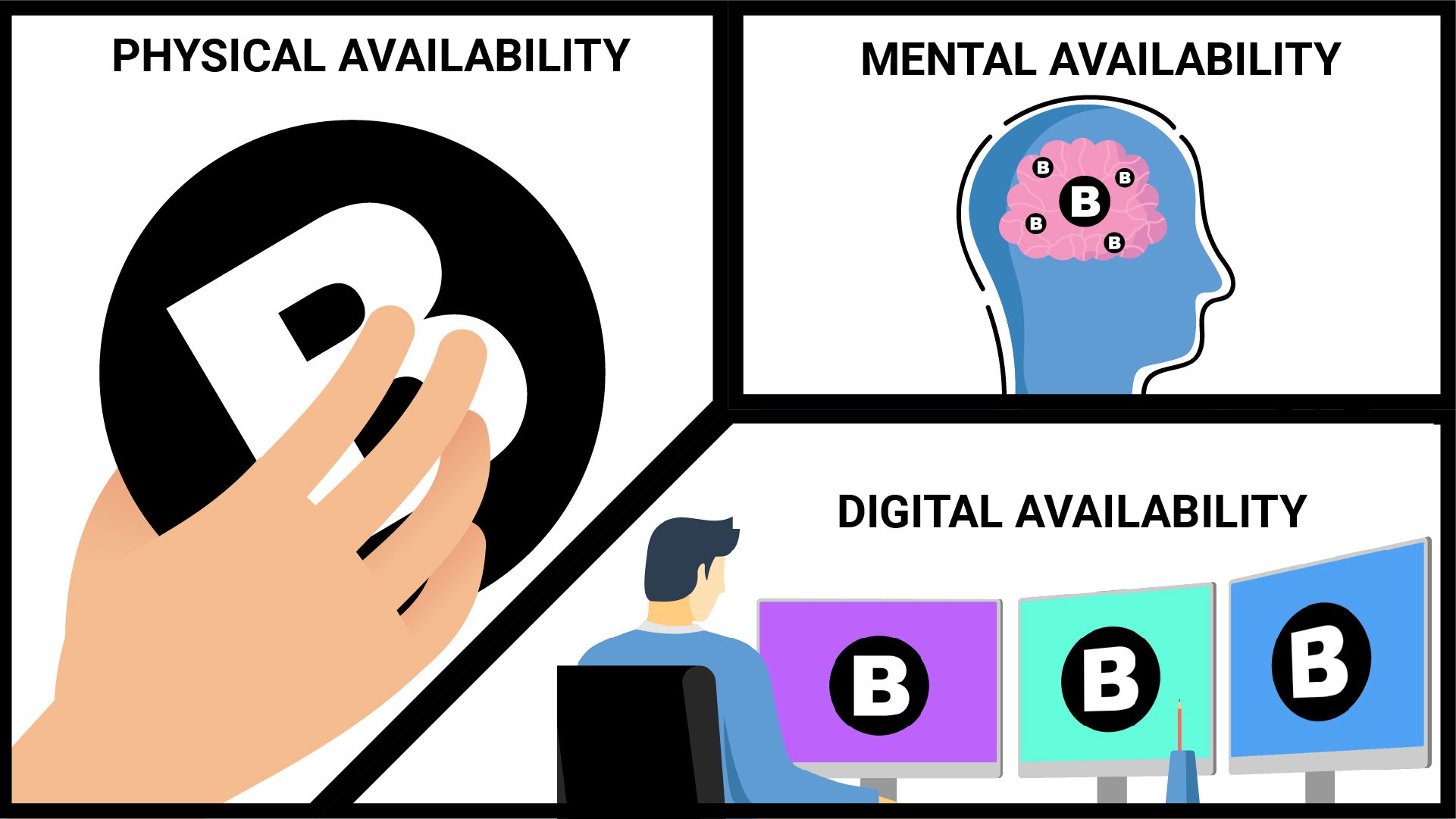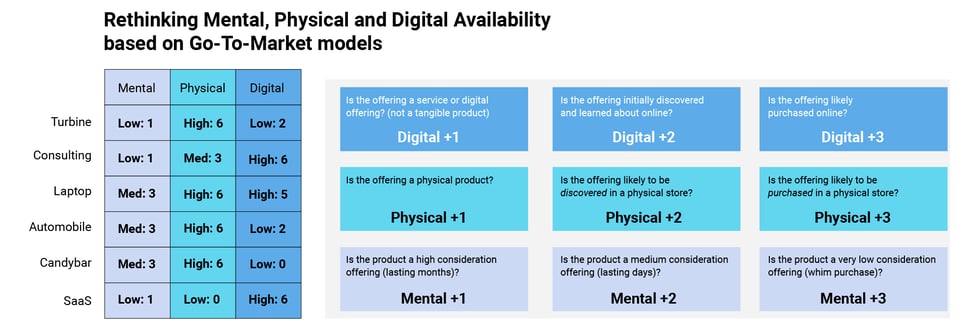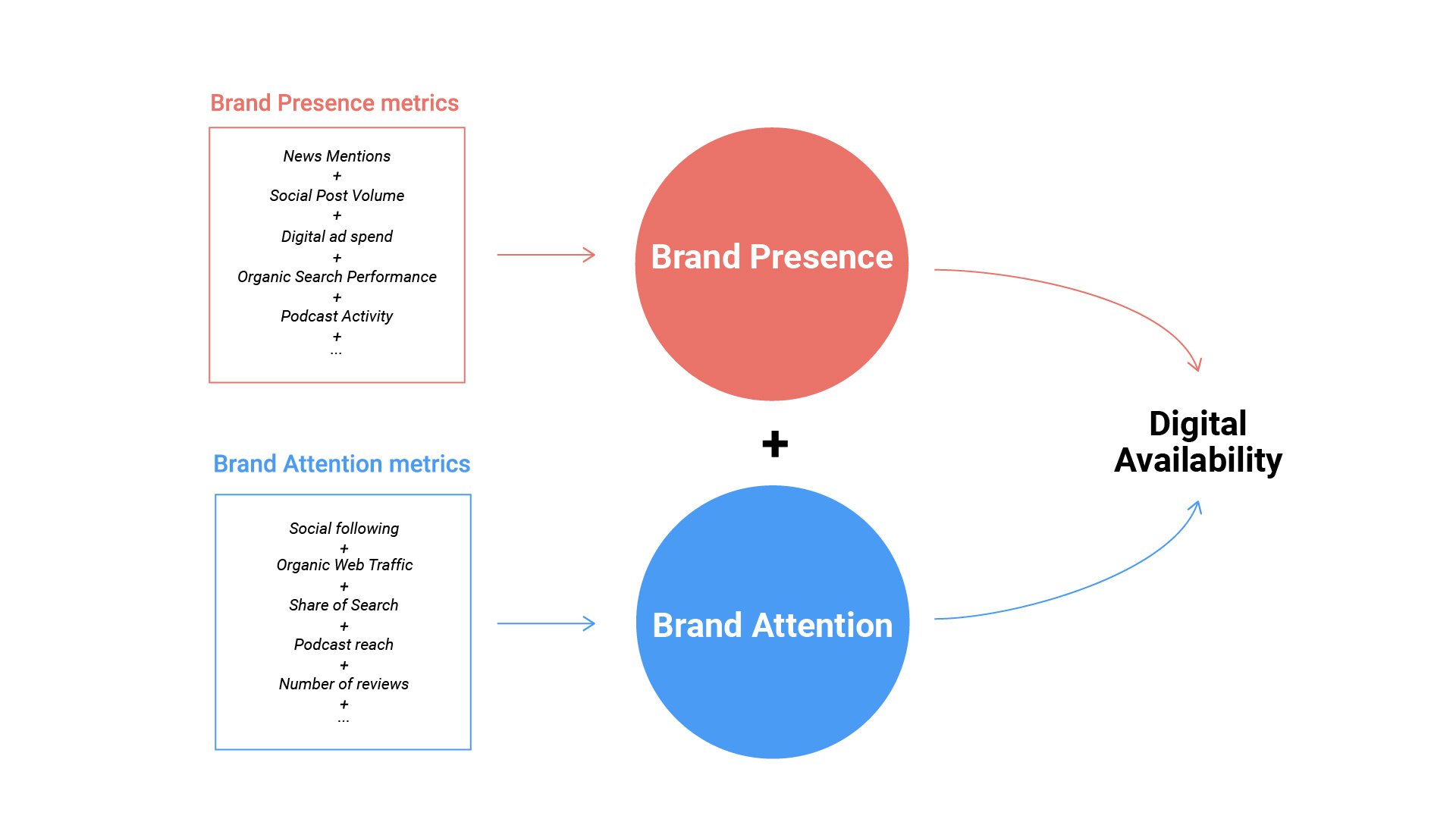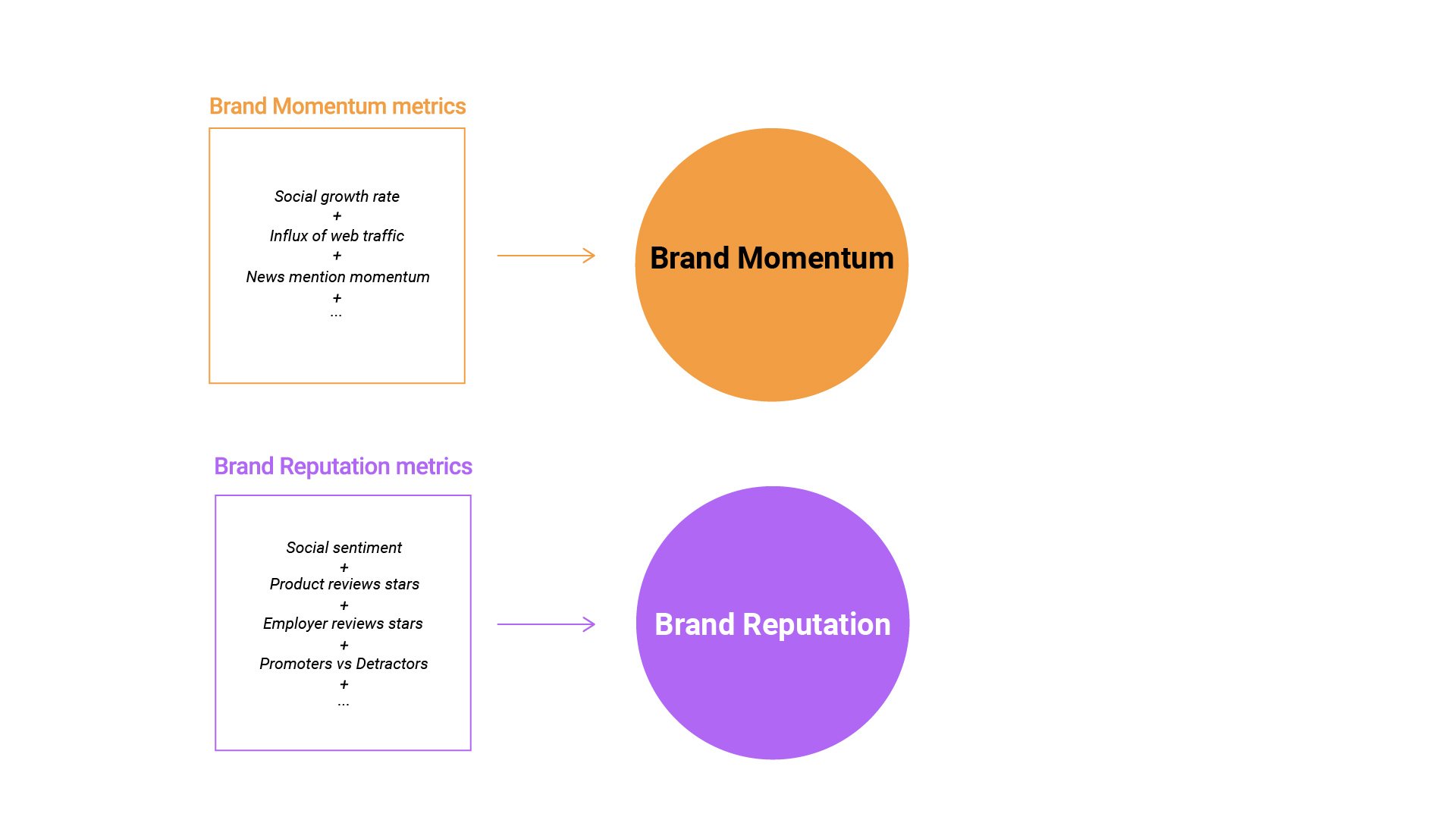Digital Availability vs Mental and Physical Availability
9 minute read
Mental and Physical Availability, meet your new sister, Digital Availability.
The more available a brand is, the easier it is for the brand to be bought by more people. According to the Ehrenberg-Bass Institute, which promoted this phenomenon, maximizing availability should be a North Star for any brand.
Mental availability is the likelihood of a brand being thought of in buying situations.
For this to happen, category buyers must first be exposed to your brand in a way that links your brand to a memory that will be triggered in a purchase situation. B2C marketers commonly orient themselves using Category Entry Points, whereas B2B marketers often use the Jobs-To-Be-Done framework.
Physical availability refers to how physically close to the buyer your brand is.
It consists of distribution (does the grocer sell your product?), supply (is your product currently stocked in the grocer's inventory?), and exposure (is your product apparent to the buyer?).
The third form of availability is digital availability. Digital availability is a long-acknowledged concept that tends to be lumped in together with physical availability. As such, it was never given a proper definition or a framework for managing it. We've reached a point where digital availability is such a prominent factor in how brands are bought that we can no longer afford to ignore it.
What is digital availability, anyway?
Digital availability refers to how discoverable and captivating your brand is across all digital channels. It expands on the marketing science discoveries which show most buyers are casual. Since most buyers are casual, the brands that are digitally dominant across all digital channels are most likely to be discovered at any point.
Achieving excess digital availability (relative to competitors in your category) is a strong predictor of market share growth. The defining characteristics of digital availability are that it's limited to digital channels, and it considers how present you are across digital channels in tandem with how much attention you earn. Some marketers have previously tried to define digital availability as mere online presence, but presence alone isn't enough. A brand might have a presence on certain online channels but get little value out of it. You've probably seen at least one Twitter account with tens of thousands of followers that get little engagement with their tweets, very few people convert to their website and even fewer people consume their message. Digital presence is valuable only if it warrants attention. Attention is the leading indicator that the presence is legitimately earned, the brand is providing value to its audience, and the presence is expected to grow more. Buyers meet digitally available brands on channels of their choice, at their pace. For brands, this is an opportunity to connect with buyers by providing them value in form of digital content. With this in mind, digital availability could be defined as a digital brand distribution that simultaneously acts as a permanent augmentation of mental availability,
attracting new buyers and as a brand's always-on digital shelf.
Digital availability is designed to support two scenarios:
1. Most category buyers will start shopping without a specific brand in mind; in fact, sometimes they might not be aware of their options at all. Instead, they often start by exploring the category. We call this the "category-first" shopping mindset. Here, buyers will start their journey with category-generic channels such as news, review sites, social platforms, and category-generic Google search queries. The more digitally present your brand is across these channels and touchpoints, the more likely you are to be discovered by "category-first" buyers.
2. If mental availability worked, then your brand came to your buyer's mind. Here, the buyer will initiate their exploration by looking at your brand, and only later will they pivot to looking at competitors. Here, buyers will start their journey with category-generic channels such as news, review sites, social platforms, and category-generic Google search queries.
Being among the first brands that buyers discover as they wander through your category allows you to be their main reference point that frames their thinking about the category. This facilitates brand affinity, builds mental availability, and increases your likelihood of winning their business. Additionally, if most buyers in your category are casual, "category-first" buyers, then maximizing digital availability will have your funnel grow more than your competitor's.
Why digital availability matters:
Growing your digital availability should be a basic requirement if your products are predominantly discovered and/or purchased online. Buyers will spend more time interacting with your brand to make a purchase decision. A recent Gartner study indicated that about 50% of a purchase journey is complete before buyers feel comfortable enough to talk to sales reps.
Brands with weak digital availability never get a look from category buyers.
Digitally dominant brands tend to be category leaders. This is supported by research that shows achieving Excess Share of Voice is directly correlated with increased market share. BrandOps has expanded on this with "Share of Everything", which confirms the eSoV findings, but with far more digital signals and channels considered. In practice, maximizing presence and attention across all digital channels is how digital availability is actually grown.
Brands with strong digital availability are perceived as category leaders and benefit from traditional brand equity.
In addition, the brands that dominate digital channels tend to be discovered before the competition. This allows the selling brand to thrust its positioning into the mind of the buyer. Here, digital availability amplifies both mental availability and the purchasing criteria.
Brands with strong digital availability are discovered first and their positioning frames category thinking.
How digital availability compares with
mental and physical availability:
Digital availability is more than just a digital extension of physical availability. What makes digital availability unique is that, unlike mental and physical availability which are pure outcomes, digital availability is both an outcome and a driver to creating it.
Digital availability is an outcome when the brand is within arm's reach to the buyer in the digital environment (e.g., on the first page of a Google search). This proximity to buyers doesn't just serve as a way to make the brand easy to be bought; it also serves as a driver of mental availability and future demand. This creates a self-sustaining growth loop. Unlike mental availability, which is traditionally built through brand advertising, digital availability builds mental availability as a byproduct of itself. In other words, the more digitally available a brand is, the more mental availability it builds. This is achieved through quality content and digital advertising. The definition of quality content is two-fold: on one hand, it might play an advertising-like role in which it stimulates attention that will have the brand's content spread and grow its digital availability even more; on the other hand, it moves prospects through the funnel and educates them about the brand's value. The former makes the brand discoverable to more people who may be casually browsing the digital channels where the brand appears, while the latter will influence demand.
Another distinction is that digital availability benefits from network effects, whereas mental availability's network effects are lesser, and physical availability rarely benefits from network effects at all. Digital algorithms are built to amplify content they deem as high quality. A brand's success on one channel will often create success on another channel. In addition to this, network effects will also be created because the brand's audiences spend time on more than one channel, and they overlap with other audiences who will get exposed to the brand by proxy. The network effects of mental availability are weaker because they depend on an individual buyer to champion the brand.
Confusing digital with physical availability
leads to suboptimal Go-To-Market strategies.
Digital availability has long been a concept without an identity of its own, but that doesn't mean it wasn't there. Knowingly or not, marketers learned to use "physical availability" as a catch-all term that often included elements of digital availability, rather than true physical availability. More than a mere issue of marketing jargon, this was bound to have negative Go-To-Market implications on brands that used them. There are simply too many differences between digital and physical availability that determine how a brand growth strategy is formulated, executed, and ultimately measured.
The basic Go-To-Market implications for physical vs mental vs digital availability are:
- Physical availability requires products to be bought in-person (brick and mortar, stores, offices, or else).
- Digital availability favors complex products that require a lot of educational content prospects can use to inform their decision.
- Mental availability favors low-consideration products for which people won't go out of their way to research alternatives.
With these basics as well as the nuances of your category considered, you can use the following framework to estimate
how much emphasis your brand should put on any of the 3 forms of availability:

There are countless stories of brands that had their business models predicated on selling products predominantly online, yet the end-all-be-all advice given to them was to maximize physical availability. Marketing dollars were wasted, growth targets weren't hit and fingers were pointed at the CMO. This confusion brought all brand-building conversations back to their default state: Category Entry Points, distinctive brand assets, and the growth patterns of FMCG companies that come packaged with these ideas. Whether these applied to your brand's unique context didn't matter. In most product categories physical and mental availability alone is not enough to make a sale. If it were, we would not see so many big, salient brands lose market share over time. Similarly, the majority of brands that grew did more than just build their association with a specific need or occasion.
Our stance isn't about digital availability being indefinitely superior to other forms of availability, it's about it being superior
depending on the context. This is something that the doctrine of mental and physical availability has yet to embrace.
Mental and physical availability lack precise measurement. Digital availability doesn't.
The extent of the mental availability of a brand varies from person to person. The category brand that's most mentally available to Susan won't be the same brand that's most mentally available to Lucy. This will change as the daily circumstances of their lives change. When the biggest value of a measure lies in the contextual insights it produces, it becomes less accurate at scale.
While we do have the next best alternative in the form of surveys, they are often limited in scope and prone to respondent bias. As a way to scale mental availability measurement, the best thing currently available are proxy metrics such as Share of Search that indicate how much "mental real estate" brands carry in people's minds at large, and how that is expressed through search. This isn't as much of a problem for physical availability, as physical availability is largely quantitative. Physical availability will rely on hard numbers that may not describe the exact physical availability for the market at scale but will get very close to it. Once this is taken into consideration, physical availability measurement techniques are better thought of as being used to answer "What's our brand's expected physical availability?" Metrics marketers use to gauge physical availability might be product distribution metrics such as the number of retail stores stocking your products, share of geographical distribution coverage, a number of shelves devoted to the brand, and more.
So long as the brand exists and operates across digital channels where the data is collected, digital availability measurement supports the best of both worlds: the nuanced insights about a brand on any given digital channel, but also the ability to get an aggregate summary. And because this data is collected directly, marketers can break down digital availability to its inputs, allowing them to see how activities and outcomes influence other activities and outcomes. This creates control over the digital availability building process. This is not the case with mental availability, where it takes 6 to 12-month intervals for mental availability initiatives to take effect, and for the marketing teams to measure it. The lagging nature of mental availability might just be a deal-breaker for most marketers who can't afford to wait so long for good data to arrive, as the corporate pressures start to pile on them.
How to measure digital availability:
MEASURING DIGITAL AVAILABILITY
Digital availability can be accurately measured using Unified Brand Intelligence platforms such as BrandOps. There are far too many digital signals and channels involved for it to be accurately measured using either the traditional methods (surveys and interviews) or modern methods (tools that focus on only one channel or data set, such as web analytics software). The core issues for those solutions are the lack of data scope, lack of data science to connect the dots, and the lack of unified data needed to measure digital availability as a standalone entity, rather than a sum of parts. Digital channels involved in measuring digital availability include social media platforms, media cast (videos and podcasts), news & PR, review sites, webinars, websites, email, digital ads, dedicated search platforms, and SERP results across non-search-focused channels. BrandOps uses a combination of brand presence and attention to measuring digital availability:
*metrics listed in these graphs are not exhaustive
The digital world makes it easy for marketers to get more data than ever before. Unfortunately, it's hard to distinguish signal from noise. This is why our metrics are divided into distinct groups called brand pillars. Brand pillars exist to group brand metrics based on their context. We mentioned at the beginning of this blog post that digital availability is a result of digital brand presence in tandem with the attention that presence generates.
Both are expressed as distinct brand pillars that are measured differently.
- Brand Presence focuses on measuring the brand's online marketing activity and the long-lasting results of those efforts. This is reflected through appropriate metrics that signal this, such as digital ad spend or the number of social posts published in a given time frame.
- Brand Attention focuses on measuring marketing success. This is reflected through metrics that focus on highlighting positive outcomes, such as the number of social followers, branded search, the online word-of-mouth traction a brand gets, and more.
OTHER BRAND PILLARS
The BrandOps platform has two more brand pillars that are not only relevant for growing digital availability but are also relevant for growing mental availability. Those brand pillars are Brand Reputation and Brand Momentum. 
- Brand Momentum indicates the growth momentum of the brand across digital channels. Brands with a very high momentum for their category might be breakaway brands, which competitors should neutralize as soon as possible while they still have a chance. Metrics included in the brand momentum pillar reflect this, such as news mention momentum, the growth momentum of the brand's YouTube subscribers, and more.
- Brand Reputation reflects how people talk about your brand online. It includes positive and negative sentiment, the extent to which those emotions are expressed, and the amount/frequency of the expressions.
The conclusion:
Mental availability and physical availability have made a tremendous impact on our understanding of how brands grow. Yet, the industry has evolved but our understanding of availability in the digital context has not been formalized. Marketers tried to fit a vastly different concept of digital availability into legacy boxes that fit our understanding of how traditional forms of availability work, but without much success. Availability is not a one-size-fits-all approach, no matter how much we'd like that to be true.
For many product categories, growing digital availability could be your most important priority.
BrandOps is a Unified Brand Intelligence platform for B2B marketers.
If you want to get a glimpse of your brand's digital availability, schedule a live walkthrough or get a free 2-week trial.


